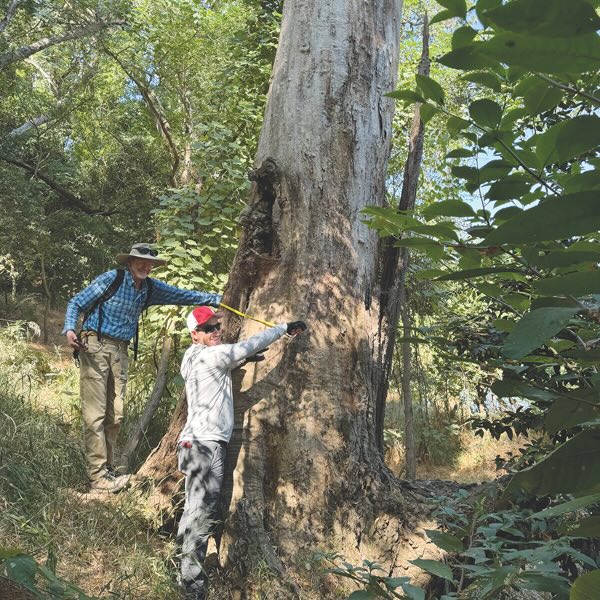‘Not Giving Up’
Flood board OKs erosion-control work on American River
By Cathryn Rakich
September 2025
Destruction of miles of riparian habitat, including hundreds of trees, along the lower American River is scheduled to begin this fall.
The Central Valley Flood Protection Board approved the U.S. Army Corps of Engineers’ latest erosion-control project, despite pleas by engineers, biologists, scientists, geologists, professors, environmentalists and community activists to rethink the devastation.
Contract 3B stretches from the Howe Avenue bridge to east of Watt Avenue. The erosion-control work is part of the Corps’ plan to protect the city from floods.
Bulldozers will demolish as many as 700 trees, including 300-year-old oaks, and established vegetation. Trucks will deposit tons of jagged rock and rubble along the banks and into the water. The river’s south and north sides will be fenced for equipment staging.

Residents can expect noise, vibrations, dust and detours. Recreational use of the river and parkway will be impacted for years.
The fight is not over, says American River Trees, a citizens group calling for a more targeted, less destructive approach.
“American River Trees is not giving up on the parkway,” environmental scientist Candice Heinz says. “We’re pursuing legal action and consulting with legal counsel” to save the parkway from unnecessary damage.
“There were significant flaws in the project that the board was willing to accept in the name of flood protection,” Heinz says.
American River Trees says the project proposal contains inaccuracies and shortcomings, and doesn’t comply with the California Environmental Quality Act. Less-destructive, nature-based solutions were not considered that could provide erosion protection while reducing habitat destruction.
At the flood board meeting, County Supervisor Rich Desmond and former City Council Member Jeff Harris spoke in favor of the Army Corps’ proposal. Dozens of experts and community members called for a pause to consider alternatives.
Civil engineer Bill Brattain told the flood board the Army Corps’ definition of a heritage oak is inaccurate. Per Sacramento County code, 37 trees in the Contract 3B work zone are defined as heritage oaks. The Army Corps applied a definition that identified only three heritage oaks in that area.
“Using [the Corps’] definition would disqualify almost every mature oak in the entire region from heritage status or protection,” Brattain said.
Heinz said the Army Corps only addresses a small pool of protected wildlife species and neglects thousands of other species that rely on the parkway habitat. “Less destructive approaches that preserve more habitat must be prioritized,” she said.
Geologist Larry Carr was “stunned,” saying the planned destruction “didn’t make sense.”
“I walk these trails every week,” Carr told the board. The riverbank “looks almost identical after every high-water event and storm.” For small areas that might erode, he advocated targeted remedies, calling the planned destruction “almost criminal.”
Resident Cindy Elliott noted the “delicate ecosystem that has been functioning perfectly well on its own.” Trees are “protecting the river’s edge, keeping all the soil and rock in place with their massive root system.”
Resident Pete Spaulding reminded the board that tree removal will cause hotter water temperatures that will impact juvenile salmon. “Use our design alternatives and leave more mature trees along the river’s edge to maintain cooler temperatures,” he said.
Barbara Domek has lived along the American River Parkway for 40 years. “We’ve seen the levy here maintained, repaired and slurry enforced,” along with upgrades to Folsom Dam.
Even with highwater events, “trees stood strong,” Domek said. “They slowed the flow of water against the levy, and they held the riverbank in place and protected it from erosion.”
Heinz said the “levies have been upgraded with seepage walls, now called Cadillac levies, due to their top-tier robustness. They were built to stand water rushing against them around the clock for 365 days a year.”
Even with the Army Corps’ habitat restoration plan, biologist Marni Fylling-Ellison said, “the fragmentation of this corridor will disrupt the life cycles of countless species of birds, fishes, mammals, insects and plants for years, for decades. Some won’t recover.”
None of the testimony mattered.
“There’s 500,000 people who need better flood protection,” flood board President Jane Dolan said.
The vote was unanimous.
For information on community opposition, visit americanrivertrees.com. For information on the Army Corps, visit spk.usace.army.mil.
Cathryn Rakich can be reached at cathrynrakich@gmail.com. Follow us on Facebook and Instagram: @insidesacramento.







